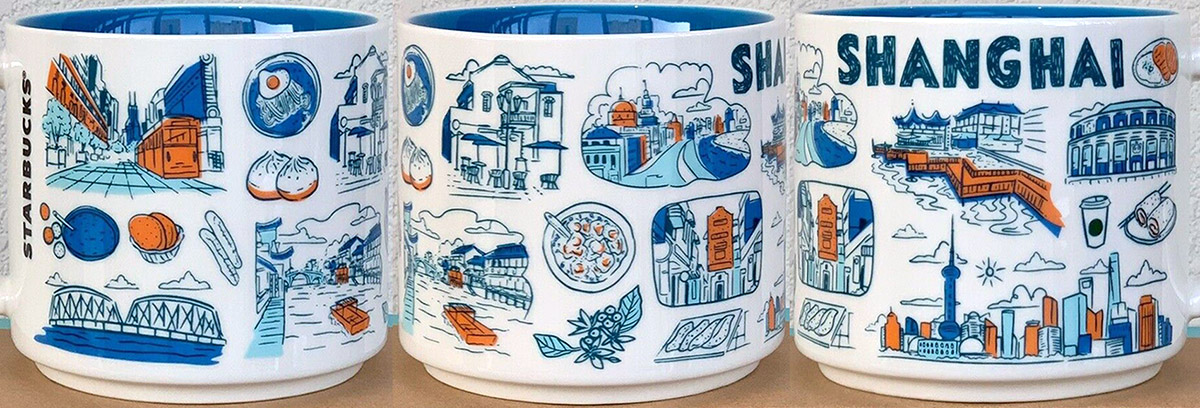
Been There – Shanghai
Starbucks Been There Shanghai is a mug for a global metropolis on China’s eastern coast that experienced transformative growth in the 19th century when it emerged as a major trading port following the Treaty of Nanking in 1842. This pivotal moment opened the city to international trade, leading to a period of rapid development and cosmopolitan influence. As foreign concessions sprang up, Shanghai became a melting pot of cultures and architectural styles, blending traditional Chinese elements with Western innovations. The city’s iconic Bund area, with its historic buildings from the early 20th century, and its modern skyline featuring skyscrapers like the Shanghai Tower, reflect this rich tapestry of history and progress. Today, Shanghai stands as a vibrant testament to its storied past, seamlessly integrating its historical charm with the pulse of contemporary urban life.
The design of the mug showcases architectural landmarks and local food specialties of the city. Here are some of them:
– Shanghai’s skyline is a striking blend of modernity and tradition, highlighted by its iconic skyscrapers such as the Shanghai Tower, the Oriental Pearl TV Tower, and the Jin Mao Tower. The skyline features a futuristic design, with sleek, soaring structures that dominate the cityscape and showcase Shanghai’s status as a global financial hub. At night, the skyline transforms into a dazzling display of illuminated buildings, creating a mesmerizing urban panorama that reflects the city’s dynamic spirit and innovative spirit.
– The Bund is a historic waterfront promenade along the Huangpu River, offering a panoramic view of Shanghai’s iconic skyline. Renowned for its early 20th-century colonial architecture, it features an array of grand buildings from the British, French, and American eras. Today, The Bund remains a popular destination for both tourists and locals, blending historical charm with the dynamic energy of modern Shanghai.
– Yu Garden, located in Shanghai’s Old City, is a classic example of traditional Chinese garden design, featuring intricately landscaped areas, tranquil ponds, and ornate pavilions. Established during the Ming Dynasty, it offers a serene escape from the bustling city, with its beautifully preserved architecture and harmonious layout reflecting classical Chinese aesthetics. Visitors can explore its charming rockeries, elegant halls, and lush greenery, making it a picturesque and historically significant site.
– Zhujiajiao Ancient Town, often called the “Venice of Shanghai,” is a well-preserved water town with a history dating back over 1,700 years. The town is characterized by its picturesque canals, charming stone bridges, and traditional wooden houses, offering a glimpse into the region’s rich cultural heritage. Visitors can stroll along the narrow streets, explore ancient temples, and enjoy local delicacies in this quaint and scenic setting, providing a tranquil escape from the modernity of Shanghai.
– Xintiandi is a vibrant, pedestrian-only district in Shanghai known for its blend of historic Shikumen architecture and contemporary design. This upscale area features a lively mix of boutique shops, international restaurants, and chic cafes, making it a popular spot for both locals and tourists. The district’s stylish restoration of traditional Shanghai houses with modern amenities creates a unique atmosphere that highlights the city’s fusion of old and new.
– Xiaolongbao (Soup Dumplings): These delicate dumplings are filled with savory broth and meat, usually pork. They’re steamed in bamboo baskets and eaten with a dipping sauce of soy sauce and vinegar.
– Shanghai-style mooncakes are renowned for their unique flavors and delicate textures. Unlike their northern counterparts, these mooncakes often feature fillings like red bean paste, lotus seed paste, or even savory options such as salted egg yolk. They are especially popular during the Mid-Autumn Festival, celebrated with family gatherings and festive activities.





















































































